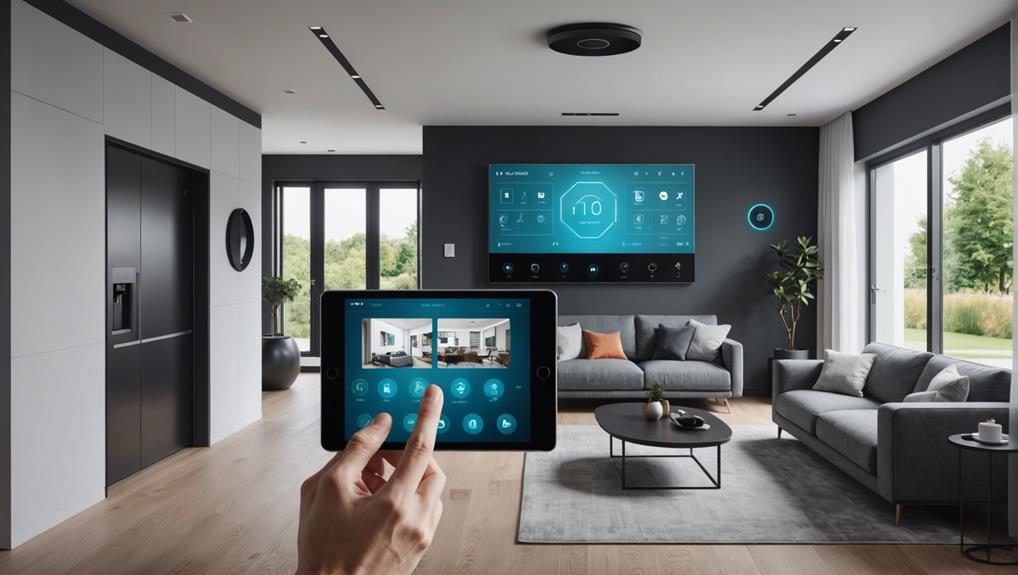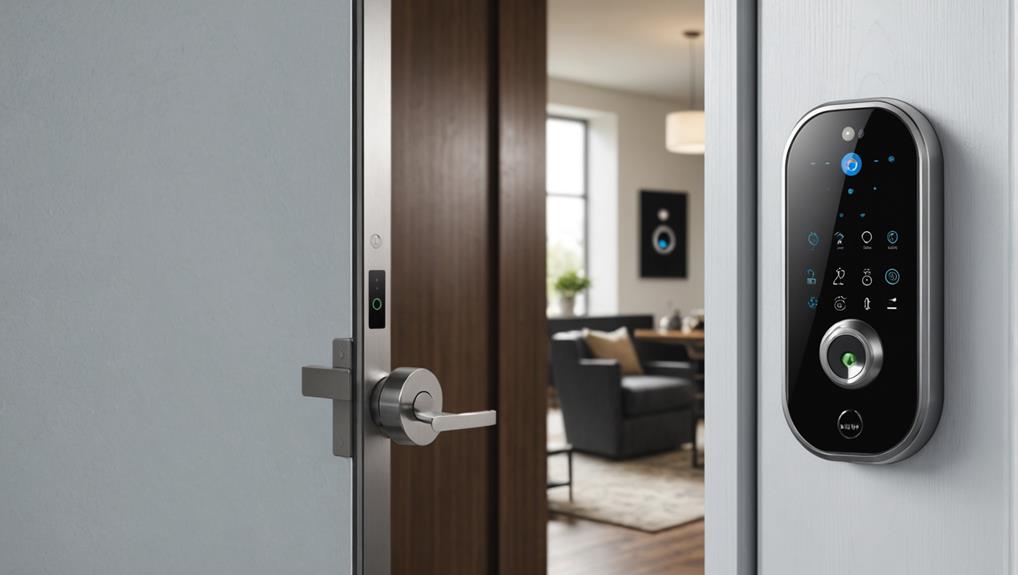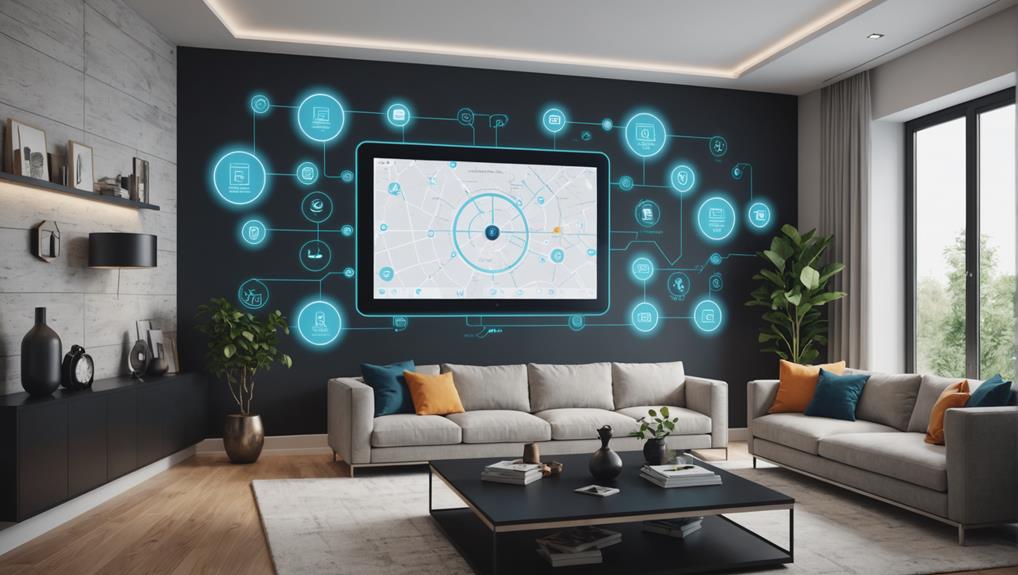You can boost your home's security by integrating it with IoT devices, which offer real-time monitoring, automated responses, and instant alerts. Smart cameras deter intruders with motion detection and night vision, while smart locks provide keyless entry and customized access codes. Motion and environmental sensors detect unusual activities and hazards like smoke or water leaks, sending immediate notifications to your smartphone. Remote access allows you to control locks and alarms from anywhere, enhancing safety and convenience. These features create a proactive approach to home security, giving you peace of mind. Discover more about optimizing home protection with IoT integration.
Key Takeaways
- Real-time alerts and notifications provide immediate awareness of unusual activity, enhancing security responsiveness.
- Remote access management allows users to control locks and monitor cameras from anywhere, offering flexibility and peace of mind.
- Automated security responses like door locking and light activation deter intruders and enhance protection.
- AI-powered analytics and advanced sensors improve threat detection and prevention capabilities.
- Integration with IoT devices ensures comprehensive monitoring and quick responses, improving overall home safety.
Understanding IoT in Home Security

Integrating IoT into home security is revolutionizing how we protect our homes. You can now transform your space into a smart home security haven, making it safer and more efficient. By integrating IoT with security, you're not just adding gadgets; you're creating a seamless network that communicates and responds to potential threats.
Imagine having real-time alerts on your phone whenever there's unusual activity around your home. IoT and security work together to provide this, making sure you're always in the loop. You're not just reacting to problems; you're proactively preventing them. This proactive approach is vital for those who value serving others, as it guarantees your loved ones are always protected. According to advanced monitoring systems, these integrated networks can even analyze patterns to detect anomalies more effectively.
Smart home security systems can include everything from smart cameras to motion sensors, all interconnected through IoT. This thorough coverage means you can monitor every corner of your home effortlessly.
The integration of IoT with security doesn't just stop at alerts; it extends to automated responses like locking doors or turning on lights to deter intruders.
In essence, embracing smart home security through IoT isn't just about technology; it's about creating a safer environment for everyone you care about.
Key IoT Devices for Home Safety

When it comes to safeguarding your home, several key IoT devices stand out as essential tools.
These smart home technologies not only provide robust security but also offer the convenience of home security connectivity, making it easier to monitor and protect your home from anywhere.
According to Transforming Home Protection, these devices are revolutionizing how we approach home security.
If you're committed to serving others, ensuring your home is secure is a great step toward peace of mind for your loved ones.
Here are four must-have IoT devices for home protection:
- Smart Cameras: These allow you to keep an eye on your home in real-time. With features like motion detection and night vision, smart cameras are a cornerstone of IoT in home protection.
- Motion Sensors: Placing these around your home can detect any unusual activity. They can trigger alarms and send alerts to your smartphone, providing immediate awareness of potential intrusions.
- Smart Alarms: Integrating with other IoT devices, smart alarms not only sound off in emergencies but also notify you via your smart devices, ensuring you're always in the loop.
- Environmental Sensors: These sensors detect smoke, carbon monoxide, and even water leaks. They offer an all-encompassing layer of protection that goes beyond just intruders.
Smart Locks and Access Control

Imagine never needing to fumble for your keys again—keyless entry systems make that possible. With the integration of IoT devices, these systems are becoming more advanced and user-friendly.
For instance, integrated alarms can now work seamlessly with smart locks to provide an extra layer of security. You can manage access remotely, ensuring your home is secure even when you're not there.
Plus, real-time activity alerts keep you informed about who's coming and going at all times.
Keyless Entry Systems
Keyless entry systems revolutionize home security by replacing traditional locks with smart locks and advanced access control mechanisms. These systems integrate seamlessly with your connected home devices, offering enhanced safety through IoT technology.
By shifting to smart locks, you not only upgrade your security but also simplify access for family, friends, or service providers who may need entry.
Imagine the convenience and peace of mind you'll gain:
- Remote Access: Grant entry from anywhere using your smartphone, ensuring your home remains secure even when you're not there.
- Customized Access Codes: Create unique codes for different people, allowing you to monitor who enters and leaves your home.
- Auto-Lock Features: Never worry about forgetting to lock the door again, as these systems can automatically secure your home after a set period.
- Integration with Other Devices: Pair your smart lock with other IoT devices like security cameras and alarms for a thorough security solution.
Remote Access Management
Imagine this: you're stuck in traffic, running late to an important meeting, and suddenly you remember you forgot to fasten your door. Instead of turning back, you can use remote access management to safeguard your home.
With smart locks and access control, you can lock or release your doors from anywhere using your smartphone. This technology not only adds convenience but also enhances your ability to serve others by guaranteeing their safety.
Remote access management allows you to grant or revoke access to your home without needing to be physically present. Imagine being able to let in a neighbor to feed your pets or allow a delivery person to drop off a package securely.
Your smartphone becomes a powerful tool, enabling you to manage who enters your home, and when.
Additionally, smart locks can be programmed with unique access codes for different family members or service providers, giving you detailed control over who's entry rights.
This system guarantees that you're always in control, even from a distance. By integrating remote access management into your home security setup, you're not just protecting your own space but also creating a safer environment for those you care about.
Real-time Activity Alerts
Remote access management offers unparalleled convenience and control, but the benefits of smart home security don't stop there.
Real-time activity alerts, especially through smart locks and access control, elevate your home's safety to a new level. Imagine receiving instant notifications whenever someone enters or exits your home. This feature doesn't just keep you informed; it empowers you to act swiftly if needed.
Here are four key benefits of real-time activity alerts:
- Immediate Awareness: You'll know right away if someone tries to access your home, whether it's your kids coming back from school or an unexpected visitor.
- Enhanced Monitoring: Keep an eye on who enters and exits your home, and at what times. This is especially useful if you have service providers or caregivers coming in regularly.
- Peace of Mind: Real-time alerts offer you the reassurance that your home's security is actively monitored, letting you focus better on serving others.
- Quick Response: In case of any suspicious activity, you can quickly notify the authorities or take other necessary actions, ensuring the safety of your loved ones.
Surveillance Cameras and Monitoring

When it comes to safeguarding your home, surveillance cameras and monitoring systems stand as essential components. They not only deter potential intruders but also give you peace of mind knowing your property is always under watch. With IoT integration, these systems have become smarter and more efficient, allowing you to monitor your home in real-time from anywhere.
| Feature | Benefit | Example |
|---|---|---|
| Remote Access | Monitor from anywhere | Check cameras via smartphone |
| High-Resolution | Clearer images & videos | Identify faces/details easily |
| Night Vision | 24/7 surveillance | See clearly in low light |
By using high-resolution cameras, you can capture crystal-clear images, making it easier to identify any suspicious activity. Night vision capabilities guarantee that your home is protected round the clock, regardless of lighting conditions. Remote access allows you to check on your property from your smartphone, making sure you're always in the loop, no matter where you are.
Incorporating these advanced surveillance systems into your home security setup not only enhances safety but also helps you serve others more effectively. Whether you're looking out for family members, neighbors, or even pets, these tools provide an invaluable layer of protection and assurance.
Motion Sensors and Detection

When you integrate advanced motion detection into your smart home, you're enhancing your security system's capability to identify unusual activities.
These sensors detect movement by monitoring changes in the environment, such as variations in infrared energy or sound waves.
They can provide real-time alerts, allowing you to respond quickly to potential threats.
Advanced Motion Detection
Advanced motion detection has revolutionized home security by making it smarter and more responsive. You can now protect your loved ones better than ever with systems that don't just sense movement but understand it.
Integrating IoT devices with advanced motion detection offers several key benefits that enhance your ability to serve and protect others.
- Precision Monitoring: Unlike traditional sensors, advanced motion detectors identify the difference between a pet and an intruder. This reduces false alarms and guarantees you're only alerted to genuine threats.
- Coverage Areas: Modern systems cover a broader range, guaranteeing every corner of your home is monitored. You can relax knowing that nothing goes unnoticed, and your family's safety is uncompromised.
- Smart Integration: Advanced motion detectors work seamlessly with other smart home devices. Lights can turn on automatically when motion is detected, or cameras can start recording immediately. This integration creates a cohesive security environment.
- Customizable Settings: You can adjust sensitivity levels and detection zones to fit your specific needs. Whether it's monitoring an entrance or keeping an eye on a specific room, you have full control.
Real-Time Alerts
Real-time alerts transform how you react to potential security breaches, ensuring you're always in the know. When your home's motion sensors detect unusual activity, your IoT-enabled devices immediately send notifications to your smartphone or other connected devices.
This instant communication allows you to take swift action, whether you're at home or miles away.
Imagine a scenario where you're volunteering at a local shelter, and your phone buzzes with an alert about unexpected movement in your backyard. Instead of worrying, you can check your security cameras right from your device and decide the best course of action.
Should you call a neighbor to check on your property, or is it just a harmless animal? Real-time alerts empower you to make informed decisions quickly, prioritizing safety for yourself and those you care about.
Alarm Systems and Notifications

Alarm systems and notifications form the backbone of a robust smart home security setup. They guarantee you're always in the loop, providing real-time updates on any suspicious activity.
When integrated with IoT devices, these systems become even more efficient, offering a seamless and interconnected safety net for your home. For instance, traditional home alarms can be greatly enhanced when integrated with smart tech, providing both security and convenience.
Here are four key benefits of smart alarm systems and notifications:
- Instant Alerts: You'll receive immediate notifications on your smartphone if any unusual activity is detected. This helps you respond quickly to potential threats.
- Customization: Tailor the notifications to your needs. Whether it's a door opening, a window breaking, or even smoke detection, you can customize alerts to prioritize what's most important to you.
- Integration with Other Devices: Your alarm system can work in harmony with other smart devices. For instance, if the alarm is triggered, your smart lights can turn on automatically, deterring intruders and guiding you to safety.
- Peace of Mind: Knowing your home is protected by a smart alarm system gives you peace of mind. You can focus on serving others, knowing your loved ones and property are secure.
Remote Monitoring and Control

Even when you're miles away from home, remote monitoring and control assure you can still keep an eye on your property. With the help of IoT devices, you can access live feeds from security cameras, receive real-time alerts, and even control your home's security systems through your smartphone or tablet.
To guarantee a seamless connection, it's vital to integrate compatible devices into your smart home security system. This seamless connection ensures that your home remains protected, allowing you to focus on serving others without worrying about your property's safety.
Imagine you're out volunteering at a community event, and suddenly you receive a notification about an unexpected movement detected at your front door. With a few taps on your phone, you can instantly view the live video feed, communicate with the visitor through a smart doorbell, or alert authorities if necessary.
This level of control and immediacy not only enhances your home's security but also provides peace of mind.
Furthermore, remote monitoring features like geofencing can automatically arm or disarm your security system based on your location. This means you won't have to worry about forgetting to set the alarm when you leave or turning it off when you return.
Embrace the convenience and reliability of remote monitoring and control to keep your home safe and secure, no matter where your mission to help others takes you.
Automating Security Responses

While remote monitoring and control keep you informed and in charge, automating security responses takes your smart home security to the next level.
Automation guarantees that your home reacts instantly to threats, providing peace of mind and allowing you to focus on serving others.
Imagine your smart home not just alerting you to potential dangers but also taking immediate action to mitigate them. This proactive approach not only enhances your security but also offers crime prevention by making your home a less attractive target for intruders.
Here are four ways automation enhances your home security:
- Instant Lockdown: If a break-in is detected, your smart home can automatically lock all doors and windows, making it more difficult for intruders to move around.
- Emergency Alerts: Your system can send instant notifications to emergency contacts and local authorities, guaranteeing help is on the way even if you can't call for it yourself.
- Lighting Control: Automated lights can turn on to simulate occupancy or to illuminate escape paths, deterring intruders and guaranteeing family members can safely exit the home.
- Surveillance Activation: Cameras and recording devices can be activated to capture evidence, which can be vital for identifying intruders and assisting law enforcement.
Future Trends in Smart Security

Smart home security is constantly evolving, and it's important to stay ahead of the curve to keep your home safe. Emerging trends promise to make your security systems smarter, more responsive, and better integrated. You'll soon see greater use of artificial intelligence (AI) to predict and prevent potential threats before they occur. AI can analyze patterns and detect unusual activities, offering a proactive approach to security.
Additionally, biometric authentication, like facial recognition and fingerprint scanning, will become more common. These technologies offer an extra layer of security, guaranteeing that only authorized individuals can access your home. You'll also benefit from advancements in smart sensors that can detect more than just motion – they can identify sound patterns, broken glass, and even changes in air quality.
Here's a quick look at some future trends in smart security:
| Trend | Description | Benefit |
|---|---|---|
| AI-Powered Analytics | Predict and prevent potential threats | Proactive security |
| Biometric Authentication | Facial recognition, fingerprint scanning | Enhanced access control |
| Advanced Smart Sensors | Detect sound patterns, broken glass, air quality | Extensive threat detection |
| 5G Connectivity | Faster, more reliable connections | Improved real-time monitoring |
| Blockchain Technology | Secure data transactions | Increased data integrity |
Staying informed on these trends guarantees you can leverage the latest technology to protect those you serve, creating a safer environment for everyone.
Frequently Asked Questions
How Does Smart Home Security Affect Property Insurance Premiums?
You're wondering how smart home security affects property insurance premiums, right?
When you install smart security systems, you're not just protecting your home; you're also reducing risks that insurers consider when setting premiums. They appreciate proactive measures.
Are There Privacy Concerns With Iot-Enabled Security Systems?
Yes, there are privacy concerns with IoT-enabled security systems.
When you're installing these devices, you're often sharing data with third-party companies. Hackers could potentially access your personal information.
To serve others best, guarantee you choose reputable brands, update firmware regularly, and use strong, unique passwords.
Can Smart Home Security Systems Work During Internet Outages?
Yes, smart home security systems can work during internet outages.
While some features might be limited, many systems have built-in local control that keeps essential functions like alarms and sensors active.
For those who want to guarantee continuous protection for others, it's important to choose a system with backup options, like cellular connectivity or battery backups, so you can still monitor and secure your home even without internet.
What Are the Energy Consumption Implications of Iot Security Devices?
When considering the energy consumption implications of IoT security devices, you'll find they generally use minimal power, but it accumulates over time.
Always be mindful of the environmental impact and costs.
Opt for energy-efficient options and integrate your devices into a smart grid.
This way, you're not only enhancing security but also serving the community by promoting sustainable living and reducing energy waste.
How Do Smart Home Security Systems Integrate With Existing Non-Smart Devices?
You can integrate smart home security systems with non-smart devices using smart plugs, hubs, or adapters.
These tools let you control traditional devices through your smart system. For example, a smart plug can turn a regular lamp into a smart light you control remotely.
Conclusion
In embracing smart home security, you're taking a proactive step toward a safer, more connected home. IoT devices like smart locks, surveillance cameras, and motion sensors work together to provide extensive protection. You can monitor and control your security system remotely, ensuring peace of mind. As technology advances, you'll benefit from even more sophisticated and automated security solutions. So, stay ahead and let these innovations keep your home secure and smart.









